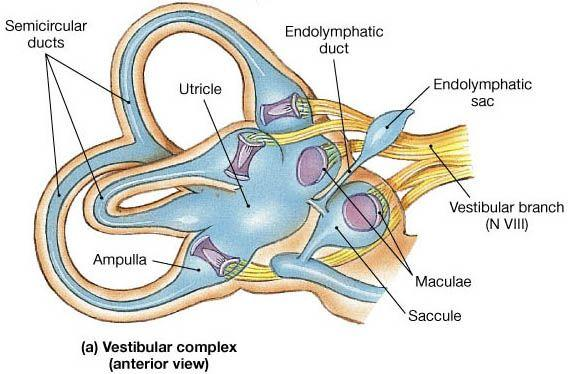Answer
425.4k+ views
Hint:A link between the inner ear and the brain helps in keeping the correct balance when moving and this is looked after by the vestibular apparatus with the help of semicircular canals and the vestibule.
Complete answer:The vestibular apparatus is a somatosensory portion of the nervous system that helps us with the awareness of the position of our head spatially and body and its motion. The vestibular labyrinth consists of these components located deep within the part of inner ear:
Semicircular canals: These comprise of the cells which monitor the angular acceleration of the head.
The Utricle and Saccule: These comprise the cells which monitor the linear acceleration of the head as well as its orientation.
The vestibular labyrinth is a hard bony cavity situated within the portion of the temporal bone. It further comprises the bony structure for the cochlea and the three semicircular canals.
The bony labyrinth consists of the three semicircular canals as well as the two otolith organs, namely the utricle and the saccule. Additionally, it contains the cochlea; the cochlea is considered to be a part of the hearing apparatus. The semicircular canals are arranged in three planes, with each of them making an approximately 90° angle with each other. The diagram given below gives a clear insight into the arrangement of these structures within the internal ear:
So, the correct answer is ‘Vestibule and semicircular canals’.
Note:The semicircular canals as well as the otolith organs are filled with fluid. Additionally, each of the semicircular canals end in a space that has small hair cells in it. These sensory hair cells in the ear are bent when we move and so does this fluid. The hair cells then send this information to the brain through the nerves.

Complete answer:The vestibular apparatus is a somatosensory portion of the nervous system that helps us with the awareness of the position of our head spatially and body and its motion. The vestibular labyrinth consists of these components located deep within the part of inner ear:
Semicircular canals: These comprise of the cells which monitor the angular acceleration of the head.
The Utricle and Saccule: These comprise the cells which monitor the linear acceleration of the head as well as its orientation.
The vestibular labyrinth is a hard bony cavity situated within the portion of the temporal bone. It further comprises the bony structure for the cochlea and the three semicircular canals.
The bony labyrinth consists of the three semicircular canals as well as the two otolith organs, namely the utricle and the saccule. Additionally, it contains the cochlea; the cochlea is considered to be a part of the hearing apparatus. The semicircular canals are arranged in three planes, with each of them making an approximately 90° angle with each other. The diagram given below gives a clear insight into the arrangement of these structures within the internal ear:
So, the correct answer is ‘Vestibule and semicircular canals’.
Note:The semicircular canals as well as the otolith organs are filled with fluid. Additionally, each of the semicircular canals end in a space that has small hair cells in it. These sensory hair cells in the ear are bent when we move and so does this fluid. The hair cells then send this information to the brain through the nerves.

Recently Updated Pages
How many sigma and pi bonds are present in HCequiv class 11 chemistry CBSE

Why Are Noble Gases NonReactive class 11 chemistry CBSE

Let X and Y be the sets of all positive divisors of class 11 maths CBSE

Let x and y be 2 real numbers which satisfy the equations class 11 maths CBSE

Let x 4log 2sqrt 9k 1 + 7 and y dfrac132log 2sqrt5 class 11 maths CBSE

Let x22ax+b20 and x22bx+a20 be two equations Then the class 11 maths CBSE

Trending doubts
Fill the blanks with the suitable prepositions 1 The class 9 english CBSE

At which age domestication of animals started A Neolithic class 11 social science CBSE

Which are the Top 10 Largest Countries of the World?

Give 10 examples for herbs , shrubs , climbers , creepers

Difference between Prokaryotic cell and Eukaryotic class 11 biology CBSE

Difference Between Plant Cell and Animal Cell

Write a letter to the principal requesting him to grant class 10 english CBSE

Change the following sentences into negative and interrogative class 10 english CBSE

Fill in the blanks A 1 lakh ten thousand B 1 million class 9 maths CBSE



